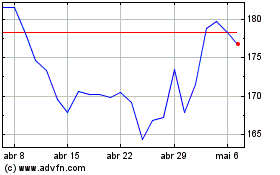Boeing to Make Key Change In 737 MAX Cockpit Software--5th Update
12 Março 2019 - 3:56PM
Dow Jones News
By Andrew Tangel and Andy Pasztor
Boeing Co. is making a significant software change to a
flight-control system in the new 737 MAX aircraft implicated in
last year's Lion Air crash, a fix that comes amid growing
world-wide unease about the aircraft's safety following a second
crash of the model.
The change, which was in the works before the Ethiopian Airlines
plane crash over the weekend, would mark a major shift from how
Boeing originally designed a stall-prevention feature in the 737
MAX when it first delivered to airlines in 2017.
U.S. aviation regulators are expected to mandate the change by
the end of April.
Boeing publicly released details about the planned 737 MAX
software update on its website late Monday. A company spokesman
confirmed the update would include a change to use multiple data
feeds in MAX's stall-prevention system -- instead of the current
reliance on a single sensor.
The change was prompted by preliminary results from the
Indonesian crash investigation indicating that erroneous data from
a single sensor, which measures the angle of the plane's nose,
caused the stall-prevention system to misfire. The series of events
put the aircraft into a dangerous dive.
Focus on the update has taken on greater urgency as aviation
regulators and airlines around the world have grounded their MAX
fleets, following The Ethiopian crash over the weekend -- despite
no links being made between the two crashes by investigators.
The MAX software change is expected to take about an hour for
each plane, a Boeing spokesman said Tuesday. He declined to offer
other details about how the system would weigh the multiple data
inputs.
"For the past several months and in the aftermath of Lion Air
Flight 610, Boeing has been developing a flight control software
enhancement for the 737 MAX, designed to make an already safe
aircraft even safer," Boeing said late Monday in a statement.
The FAA has decided to allow the 737 MAX to continue flying, a
break with counterparts in countries including the U.K., Australia
and Singapore, which grounded the model in recent days.
The investigation into the Oct. 29 Lion Air crash is continuing,
but has focused on the stall-prevention system, apparent
maintenance lapses and potential pilot error. Investigators have
revealed little about the circumstances leading up to the Ethiopian
crash, but have found cockpit voice and data recorders.
Boeing had initially designed the system to rely on data from a
single sensor that measures what is technically known as the
angle-of-attack. Engineers determined such a design would be
simpler and was in line with the plane maker's long-held philosophy
to keep pilots at the center of cockpit control, a person familiar
with the matter said.
Boeing's earlier design of the flight-control system, known as
MCAS, has puzzled some pilots and safety experts, who wondered why
the system didn't rely on multiple angle-of-attack values.
Mike Michaelis, chairman of the safety committee at American
Airlines Group Inc.'s pilot union, welcomed news of the coming
Boeing software fix.
"That's the way it should have been in the first place," he
said.
Write to Andrew Tangel at Andrew.Tangel@wsj.com and Andy Pasztor
at andy.pasztor@wsj.com
(END) Dow Jones Newswires
March 12, 2019 14:41 ET (18:41 GMT)
Copyright (c) 2019 Dow Jones & Company, Inc.
Boeing (NYSE:BA)
Gráfico Histórico do Ativo
De Abr 2024 até Mai 2024

Boeing (NYSE:BA)
Gráfico Histórico do Ativo
De Mai 2023 até Mai 2024
